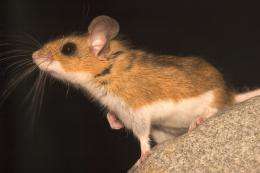New research discovers metabolic adaptation to high altitudes

When mammals are cold, they can employ physical changes to stay warm -- such as intense shivering. Like any form of aerobic exercise, though, "shivering thermogenesis" is especially challenging at high altitudes because there is less oxygen in the thin mountain air. So how do high-altitude mammals maintain a constant body temperature in low-oxygen, extremely cold alpine environments?
In a publication this week in the online edition of the Proceedings of the National Academy of Sciences from the lab of University of Nebraska-Lincoln evolutionary biologist Jay Storz, lead author Zachary Cheviron reports a discovery on how high-altitude deer mice have evolved to meet the combined challenges of hypoxia and cold exposure.
Cheviron, a former post-doctoral researcher in Storz's lab who recently became an assistant professor in the School of Integrative Biology at the University of Illinois at Urbana-Champaign, said the discovery reveals how evolved changes in gene expression (changes in the rate at which genes are transcribed) modulate aspects of energy metabolism.
Cheviron conducted experiments analyzing expression patterns of more than 15,000 genes in the skeletal muscle of deer mice from high- and low-altitude environments.
The high-altitude mice in the study were collected from the summit of Mount Evans, Colo., at 4,350 meters (14,355 feet) above sea level in the southern Rocky Mountains, and the low-altitude mice were from Nine-Mile Prairie near Lincoln. The mice were acclimated at low altitude for six weeks, and their "thermogenic capacities" were tested in a simulated hypoxic (low-oxygen) atmosphere similar to the summit of Mount Evans. The experiments revealed that highland mice have significantly higher thermogenic capacities under low-oxygen conditions than the lowland deer mice.
Surprisingly, the experiments also revealed that the highland mice have evolved a modified energy metabolism in which fatty acids constitute the primary "fuel," while the lowland mice rely primarily on carbohydrates.
The "fat to the fire" strategy employed by the highland mice is quite different from what has been documented in humans at high altitude and runs counter to the conventional wisdom about optimal metabolic strategies under hypoxia.
"What we know about humans at high altitudes, including Tibetans and Andeans, is that they have opted for a metabolic strategy of burning carbs instead of fat," Cheviron said. "Fats take a lot of oxygen to burn, but they also have a higher energy yield per unit of fuel consumed. Thus, the optimal metabolic strategy may be different for animals that have different thermoregulatory demands."
Storz's lab specializes in research on the genetics of high altitude adaptation, and this discovery marks the third time since 2008 that its research has been selected for inclusion in a major international scientific journal. The newly published work provides an example of how functional genomics (the study of functional variation in an organism's full complement of genes) can shed light on mechanisms of evolutionary change in natural populations.
Storz's and Cheviron's co-authors are Gwendolyn Bachman, also from UNL, and Alex Connaty and Brant McClelland at McMaster University in Hamilton, Ontario.
More information: The publication is online May 14-18 at www.pnas.org/cgi/doi/10.1073/pnas.1120523109
Journal information: Proceedings of the National Academy of Sciences
Provided by University of Nebraska-Lincoln


















